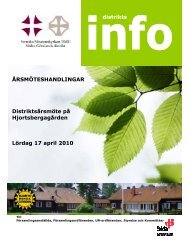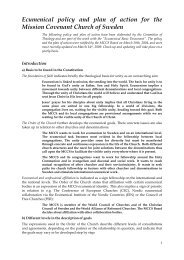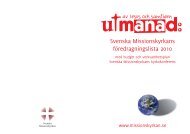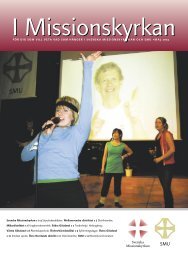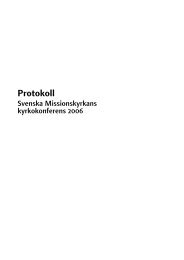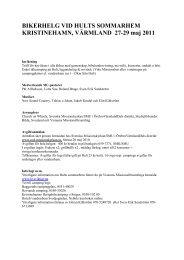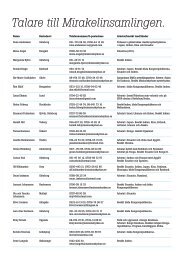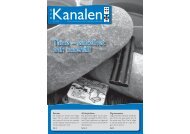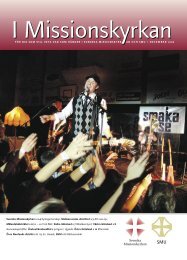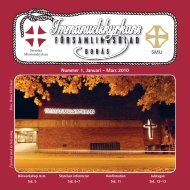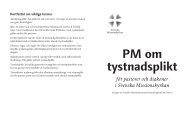Mission and Revolution in Central Asia - Svenska Missionskyrkan
Mission and Revolution in Central Asia - Svenska Missionskyrkan
Mission and Revolution in Central Asia - Svenska Missionskyrkan
Create successful ePaper yourself
Turn your PDF publications into a flip-book with our unique Google optimized e-Paper software.
total population <strong>in</strong> X<strong>in</strong>jiang. In 1941-1942 Uighur numbered<br />
2, 941,000, constituted more than 80% of the total population, the<br />
Han Ch<strong>in</strong>ese numbered 200,000, only constituted around 5 % of<br />
the prov<strong>in</strong>ce’s total population. Now the Uighur population<br />
exceeds 8,250,000 (Ch<strong>in</strong>ese government census <strong>in</strong> 1999), which<br />
constitutes 46.48 % of the total population <strong>in</strong> the Autonomous<br />
Region, a result of massive Han Ch<strong>in</strong>ese migration <strong>in</strong>to this region<br />
s<strong>in</strong>ce the early 1950’s.<br />
East/ern/ Turki The language spoken <strong>in</strong> the East Turkestan. Today called “Uighur<br />
Language”. Modern Uighur is a Turkic language of the Eastern or<br />
Chaghatai branch. Now it is commonly said to have been<br />
”Uighur”. This is the designation of a modern Turkic<br />
language (Uyghur tili or Uighurche) used by the majority of the<br />
Turkic speak<strong>in</strong>g sedentary population <strong>in</strong> north-western Ch<strong>in</strong>a.<br />
Among western scholars, especially Swedish <strong>Mission</strong>aries, it has<br />
been referred to as “Eastern Turki” <strong>in</strong> general. It is most closely<br />
related to the modern Uzbek Language.<br />
The number of the native Uighur-speakers is currently<br />
estimated at ten million. Modern Uighur does not serve as the<br />
official language of any <strong>in</strong>dependent nation. It does, however,<br />
serve as the regionally official l<strong>in</strong>gua franca among the various<br />
ethnic groups <strong>in</strong> X<strong>in</strong>jiang Uighur Autonomous Region, who do<br />
not use Ch<strong>in</strong>ese as their first language.<br />
East/ern/ Turkish See Eastern Turki<br />
Fengsiang Geographical name<br />
General Assembly (the) Short for the General Assembly of the <strong>Mission</strong> Covenant Church<br />
of Sweden. Annual assembly or conference of the MCCS.<br />
Hami (Kumul) Geographical name. A city of the eastern part of X<strong>in</strong>jiang <strong>and</strong><br />
border<strong>in</strong>g with the Gansu prov<strong>in</strong>ce <strong>in</strong> the north-western Ch<strong>in</strong>a.<br />
Kumul is a ancient city which is called “Hami” <strong>in</strong> Ch<strong>in</strong>ese. They<br />
produce the well-known fruit – “Hami melon”. It is 595 km from<br />
the prov<strong>in</strong>cial capital city of Urumchi, on the west side.<br />
Hancheng Geographical name. Hancheng mean<strong>in</strong>g is “Ch<strong>in</strong>ese city”, it is<br />
located eastern side of Kashgar <strong>and</strong> is only 20 km from the<br />
Kashgar city. Now it is called “Shufu” <strong>in</strong> Ch<strong>in</strong>ese, <strong>and</strong> called<br />
“Yengi Shehr” <strong>in</strong> Uighur. It is a county, belong<strong>in</strong>g to the Kashgar<br />
adm<strong>in</strong>istrative district.<br />
Headquarters Short for MCCS headquarters<br />
Jarkend Geographical name. A famous city <strong>in</strong> the southern silk road.<br />
It is located eastern side of Kashgar. Today called Yark<strong>and</strong> <strong>in</strong><br />
Uighur, “Shache” <strong>in</strong> Ch<strong>in</strong>ese. It is one of the biggest cities <strong>in</strong><br />
Southern X<strong>in</strong>jiang, with a population of about 700,000 people.<br />
Jengi-Hessar Geographical name. A small city near Kashgar, which is<br />
located between Kashgar <strong>and</strong> Yark<strong>and</strong>. It was well-known for<br />
Thenife-production. In Uighur called Yengi – Hissar, In Ch<strong>in</strong>ese<br />
Called “Y<strong>in</strong>gjisha”.<br />
2



